WONDER PROJECT J - KIKAI NO SHŌNEN PĪNO
|
|
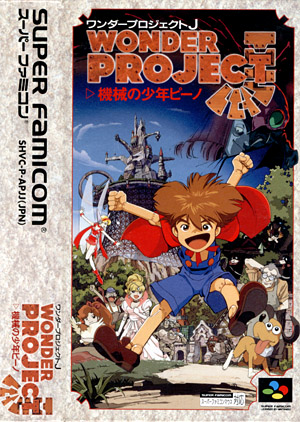
|

|
|
ワンダープロジェクトJ 機械の少年ピーノ
© Enix/Almanic/Mint/1994
Release: 1994-12-09 (¥11800)
Cartridge SHVC-APJJ
Adventure / Action game
|
Wonder Project J is an action/simulation/adventure game
developed by Almanic and published by Enix, but it
is also a game like no other that doesn't really fit neatly in any
defined genres. The story takes place on Koruro island
(aka Corlo island), a place where androids and humans live
in peace - or at least, they used to. Their relationship has been
plagued by hostility and mistrust, and a bitter feud has been
growing between the two sides. The game begins as Dr Gepetto,
a gifted craftsman, puts the last touches on his latest creation - an
articulated Gijin (an android) child named Pīno.
But for unknown reasons, the scientist is arrested and thrown in jail
and the poor Pīno is left all by himself. The goal of the game
is to help the little android boy and to teach him how to move around
and explore his new world. Interestingly, the player doesn't directly
control Pīno, but instead uses an interface-robot called
'Tinker'. The cute flying fairy can attract Pīno's
attention, ask him to walk in one direction, or stop, or help him
pick up and use objects. And Pīno starts out as a really
naive boy who needs to grow and learn a lot! The player literarily
has to train the robot child, encourage him to repeat actions over
and over, or teach him what is right from wrong (by praising and
scolding him). However, the core gameplay of Wonder Project J
is a lot more subtle and Pīno rarely knows how to respond to
new stimuli, and will simply try to eat any object he sees for the
first time. But, in the end, this long training will slowing develop
his inate abilities (such as attack, defense but also
confidence, honesty or kindness) and will
eventually activate all seven circuits of his robotic heart
(as well as the mysterious 'Circuit J'), and maybe help
humans and robots live in peace and harmony. Wonder Project J
consists of ten acts and is single player only.
|
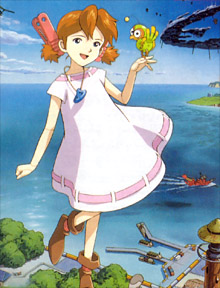 Wonder Project J is undoubtly based on Carlo Collodi's
classic novel the Adventures of Pinocchio originally published
around 1883. However, Wonder Project J has many more parallels to
Walt Disney's take on the tale. Pīno, like Disney's
Pinocchio, is a really appealing and innocent character helped by a
secondary character who symbolizes his conscience (Disney's
Jiminy Cricket certainly served as a base to design Tinker).
The game has also obvious influences from Osamu Tezuka (Astro Boy)
and Studio Ghibli/Hayao Miyazaki (Laputa,Totoro).
Wonder Project J is undoubtly based on Carlo Collodi's
classic novel the Adventures of Pinocchio originally published
around 1883. However, Wonder Project J has many more parallels to
Walt Disney's take on the tale. Pīno, like Disney's
Pinocchio, is a really appealing and innocent character helped by a
secondary character who symbolizes his conscience (Disney's
Jiminy Cricket certainly served as a base to design Tinker).
The game has also obvious influences from Osamu Tezuka (Astro Boy)
and Studio Ghibli/Hayao Miyazaki (Laputa,Totoro).
A sequel to this unusual game followed for the Nintendo 64 in 1996 (picture on the left).
This second episode, called Wonder Project J2 Koruro no Mori no Jozetto
(aka "Josette from the Koruro forest"), stars a robot girl called Josette,
helped by a bird robot-interface (which replaces Tinker).
|
|
Wonder Project J was fan translated in English by WakdHacks in 2001.
The excellent English patch was produced by LordTech and translated by
Kagami, Akujin and Tomato.
|
Game Staff (Copied from the end credits) :
|
- CAST -
Hero ... Gijin 4649
Doctor ... Geppetto Lamarck
Tinker ... Gijin 4648
No.46 ... Gijin 4600
King ... Adams Koruro
Messara ... Gijin 4646
Farmer ... Famu uizādo
Adventurer ... Addo kingā
Minato Mamoru ... Gamechī Pōto
Danchō ... Piēru Kīton
Shopkeeper ... Mimi Anjeraito
Woman Fighter ... Jannu Nora
Man Fighter ... Gādī Nora
Wildcat ... Rubī Karen
First Subordinate ... Jon Bō
Second Subordinate ... Pōru Dorō
Clerk ... Pei Sōrudo
Kyōgi-in ... Kattā Rī
Giryuu ... Gijin 4630
Dog ... Chiro
Cat ... Mī
Chicken ... Kokko
Savior ... You
- STAFF -
Almanic Staff
Game Design, Script
Yoneda Takashi
Program
Yamahiko Hiroko
Sorimachi Takashi
Shiotani Hiromitsu
Background Art Effect
Fujioka Hidetoshi
Object Design
Matsui Ryūsaku
Niyama Kyōko
Kosuge Nobori
Special Thanks
Yokokura Hiroshi
Jō Takashi
Hayakawa Naoyuki
Wakatsuki Yasuo
Animation Staff
Director
Īda Umanosuke
Image Voice
Hidaka Noriko
Character Design
Kawamoto Toshihiro
|
|
Original Art
Kaneko Masashi
Animation
Kobayashi Sachiko
Masubuchi Junko
Ōtani Kumiko
Kanbara Yoshimi
Character Color Design
Iriomote Michiyo
Screen Design
Īda Umanosuke
Enix Staff
Chida Yukinobu
Honda Keiji
Maruyama Shigeki
Saitō Mina
Takado Ittetsu
Saitō Yōsuke
Artwork
Yamamoto Hideki
Ōishi Naoki
Publicity
Sone Kōsei
Saitō Yoshihisa
Ōtsuka Mitsuru
Shimamura Ōsan
Technical Support
Yahagi Sadao
Kanō Kenjirō
Takeshita Zenrō
Honma Kazufumi
Īda Mariko
Special Thanks
Kakizawa Minoru
Wakabayashi Kaoru
Suginaka Naoto
Kuroda Hirofumi
Arai Akira
Takahashi Midori
Shigeno Akimune
Nakamura Reiri
Abe Masaki
Saitō Masakuni
Tanaka Hiroomi
Sasaki Yutaka
Ishizuka Daisuke
Matsumoto Keisuke
Hayashi Tsutomu
|
|
Title Collaborators
Fukuzaki Mika
Akaboshi Masakō
Arai Mayumi
Iwaki Hirokazu
Endō Kazumi
Ōtani Taku
Okada Hirofumi
Oshiki Sayaka
Ono Hitoshi
Kakino Takako
Kanazawa Asuka
Kawashima Shinya
Kihara Junji
Kuriki Morito
Koike Kazuhiro
Koizumi Ikue
Satō Hiroshi
Sano Nobuhito
Shinomori Toshihiro
Tamura Asubu
Tsuzuki Yoshiaki
Togasaki Mutsumi
Tokuda Kiyomi
Toyohara Katsuo
Nakamura Miwa
Hatanaka Tomoyuki
Hayashi Megumi
Mikami Ryōsuke
Mizutani Takayuki
Yamamoto Akihiro
Umano Shinya
(In alphabetical order)
Music
Mori Akihiko (Mint)
Sound Program
Hirasawa Michiya (Mint)
Recording
Wakabayashi Kazuhiro (Omnibus Promotion)
Director
Yoneda Takashi (Almanic)
Producer
Fujimoto Hiroki (Enix)
General Manager
Tomiyama Noriyuki (Almanic)
Publisher
Fukushima Yasuhiro (Enix)
Enix/1994
Almanic/1994
Mint/1994
Planning and Production
Enix (Co. Ltd.)
Almanic (Co. Ltd.)
|
|
G
O
O
D
I
E
S
|
|
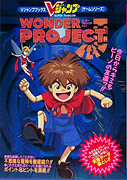
Japanese Guidebook
|
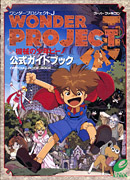
Japanese Guidebook
|
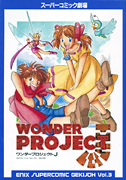
Japanese Comic book
|
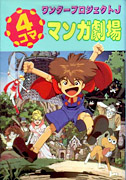
Japanese Comic book
|
|
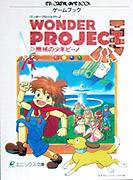
Japanese book
|
|
|
O
M
A
K
E
|
|
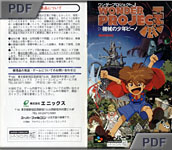
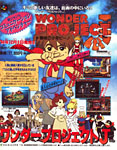
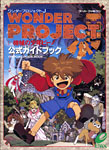
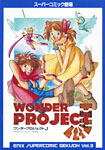
|
|
|
Click on picture to enlarge |
S
E
C
R
E
T
S
|
|
Gameplay Tips:
Controls in Wonder Project J are simple but take some time
to get used to. Here are important things to know about:
Pīno runs on health and energy (symbolized by a heart and a green spark at the top
of the screen). To refill them, either give him a health battery
 or an energy battery
or an energy battery
 ,
or get him to rest in Gepetto's house albeit at the cost of one in-game day (use Tinker to point at the big computer at
the back of the room). ,
or get him to rest in Gepetto's house albeit at the cost of one in-game day (use Tinker to point at the big computer at
the back of the room).
Button A tells Pīno to walk (or run) in one direction.
Button B tells Pīno to stop.
Button A over an object tells Pīno to use that object.
Once Pīno has used the object, praise him if he did the right action (press X),
or scold him if he hasn't (press Y). Press Y twice to hit him with a mallet.
Make sure you don't scold him too much or he will stop listening to you (give him a
pudding  to boost his trust).
to boost his trust).
Hold button B over an object to grab it, move it around or store it in your inventory.
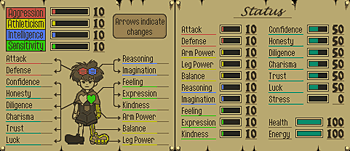 Press Select to see Pīno's status screen. There are listed a series of
attributes - they come in four different categories and they increase or decrease
based on Pīno's actions. Beside, four lights are located at the top of the
screen and indicate which category has changed after an action - Red
(combat/aggression), Yellow (strength/Athleticism), Blue (intelligence),
Green (Sensitivity). Here are all the parameters (pictures on the right, all borrowed from
the excellent English version by WakdHacks).
Press Select to see Pīno's status screen. There are listed a series of
attributes - they come in four different categories and they increase or decrease
based on Pīno's actions. Beside, four lights are located at the top of the
screen and indicate which category has changed after an action - Red
(combat/aggression), Yellow (strength/Athleticism), Blue (intelligence),
Green (Sensitivity). Here are all the parameters (pictures on the right, all borrowed from
the excellent English version by WakdHacks).
Alternate ending:
The game features a second ending. Start a new game after you've completed Wonder Project J once
(after the end credits). Make sure you complete the game again as fast as possible (the in-game
days do matter this time around, so avoid resting in Gepetto's computer if possible).
You should then reach the alternate ending where Pīno somewhat "becomes" a real boy.
|
|
|
|
LK

|
|
Add your Pov here !
|
P
O
V
s
|
|
Wonder Project J is an incredible game and it is such a shame that
it was never officially translated to English or released outside its
home country... I must warn you that an understanding of Japanese is required
in order to enjoy this game, or your first interaction with the game will be
very frustrating... Thankfully, it is now possible to find an excellent English
fan translation and several walkthroughs - so you have no excuse for missing out
on this one! Almanic (the developer behind the excellent E.V.O)
created here a really unique game, and only watching Pīno interact
with his surrounding is very entertaining in itself (and the way how the
praising/scolding is implemented is excellent!). The story is absolutely
fantastic, the anime-esque graphics and the various animation cycles are
outstanding (some of the best for the system!) and the game has lost none
of its unique charm, even to this day. But I must warn you, Wonder Project J
is not for everyone and the game often rewards patience over speed of action.
For that reason, the teaching process can become tedious at times and it may
not suit all players. But, all in all, Wonder Project J is a charming
game that defies categorization, a
game with an unique and diligently designed gameplay system,
a game with tons of heart and emotion and filled
with characters you won't soon forget.
A true masterpiece, and Almanic
and Enix at their best.
|
|
|
|